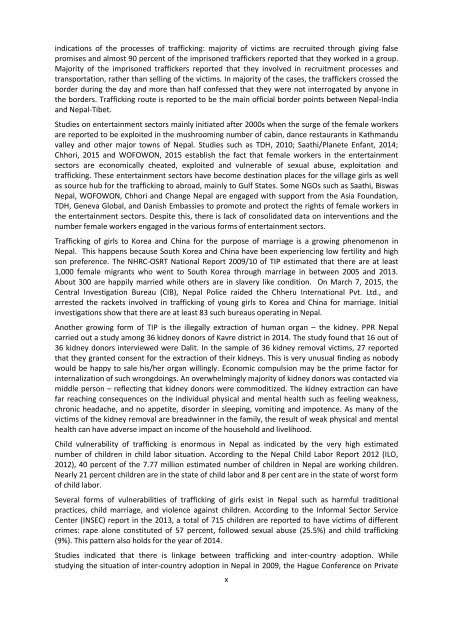TRAFFICKING IN PERSONS
1Spfyta
1Spfyta
Create successful ePaper yourself
Turn your PDF publications into a flip-book with our unique Google optimized e-Paper software.
number of poor both would substantially increase in mountains and central hills of Nepal. The<br />
absolute number of poor at the national level, on the assumption of earthquake impact of medium<br />
will be nearly 800,000.<br />
It has been estimated that nearly 95 million work days have been lost; the drop-out rate of students<br />
at grade 8 is almost one percentage point higher than that of the national average and nearly 44<br />
percent of the affected population are children under 18 years of age. Further, a large number of<br />
children have turned to be vulnerable for trafficking and exploitation as they ended up as orphans or<br />
children without parental or guardian care. According to the Center Child Welfare Board, CCWB<br />
(2015), 176 children had become orphans, 865 children’s mother died, and 972 children’s father<br />
died. And a total of 2,107 children are reported to be injured. Of the total 8,790 deaths from the<br />
quake, 2737 were children (31% of the total deaths).<br />
There are evidences that the magnitude of TIP especially of women and children has increased after<br />
the earthquakes. Media has widely provided space for the risk of trafficking of women and children.<br />
Records of Nepal Police indicate that a total of 1,233 women and children were reported to be<br />
missing during three months of the earthquake and the Nepal Police rescued 161 children from<br />
different border points between Nepal and India in the same period. Maiti Nepal’s data on the<br />
number of women and children intercepted before and after three-months of the earthquake reveal<br />
that the risk of trafficking increased after the earthquake by at least 15 percent. It is mostly Thori – a<br />
bordering area in Parsa district, and Jhapa, Illam and Mahendranagar have experienced the surge of<br />
number intercepted women and children.<br />
Responses to earthquake disaster in general and prevention of TIP in particularly were evident from<br />
a number of Governmental agencies, security forces, UN agencies, I/NGOs and civil society<br />
organizations, faith based or non-faith based organizations. NHRC carried out a monitoring study of<br />
earthquake hit districts and recommended the GoN for immediate relief of the victims of the quakes<br />
by ensuring the protection of children and women from violence and trafficking. A ‘Protection<br />
Cluster’ is formed comprising of GOs, UNs and civil society organizations for the effective and<br />
coordinated efforts to provide services to the survivors of the earthquakes and prevent TIP<br />
especially women and children. The Protection Cluster is chaired by the Honb’le Commissioner of<br />
NHRC and co-chaired by the Joint Secretary of MoWCSW. A total of 17 organizations have been<br />
found to be working under Protection Cluster in the 14 most earthquakes affected districts.<br />
According to the UN estimate, a total of US Dollar 13.71 million is required for protection<br />
component – accounting of 3.3 percent of the total US Dollar of 422 million budgets required for the<br />
earthquake affected populations.<br />
Key challenges evolved are the following: producing the reliable information/data on the impact of<br />
the earthquake; strengthening the role of the Protection Cluster; minimizing the overlap in program<br />
interventions; reducing the dropout rates of students by increasing access to schooling of children<br />
and building the public infrastructures.<br />
On Foreign Labor Migration and Nexus of TIP<br />
Migration, especially circular migration is seen as developmental beneficial for both origin and<br />
destination countries. However, it has also brought tremendous social costs among the migrants as<br />
well as their families and communities: it has closely linked to forced labor and trafficking.<br />
International migration from Nepal has been a long history. Accordingly to the Population Census<br />
2011, the absentee population consisted of 1.9 million but it is age and sex selective: of the total<br />
absentee population, 88 percent are males while rest 12 percent are females and 77 percent are in<br />
the age range of 15-35 years. Among the caste/ethnic groups, the highest proportion of absentee<br />
population is recorded among hill Dalit (10%), followed by hill Janajati (8%) and hill caste group<br />
(7.6%), Muslims (5%), Madeshi Janajati (3.9%), caste group (3.7%) and Madeshi Dalit (3.5%).<br />
Migration to India has been a long history in Nepal. However, the proportion of migrants to India has<br />
xii


